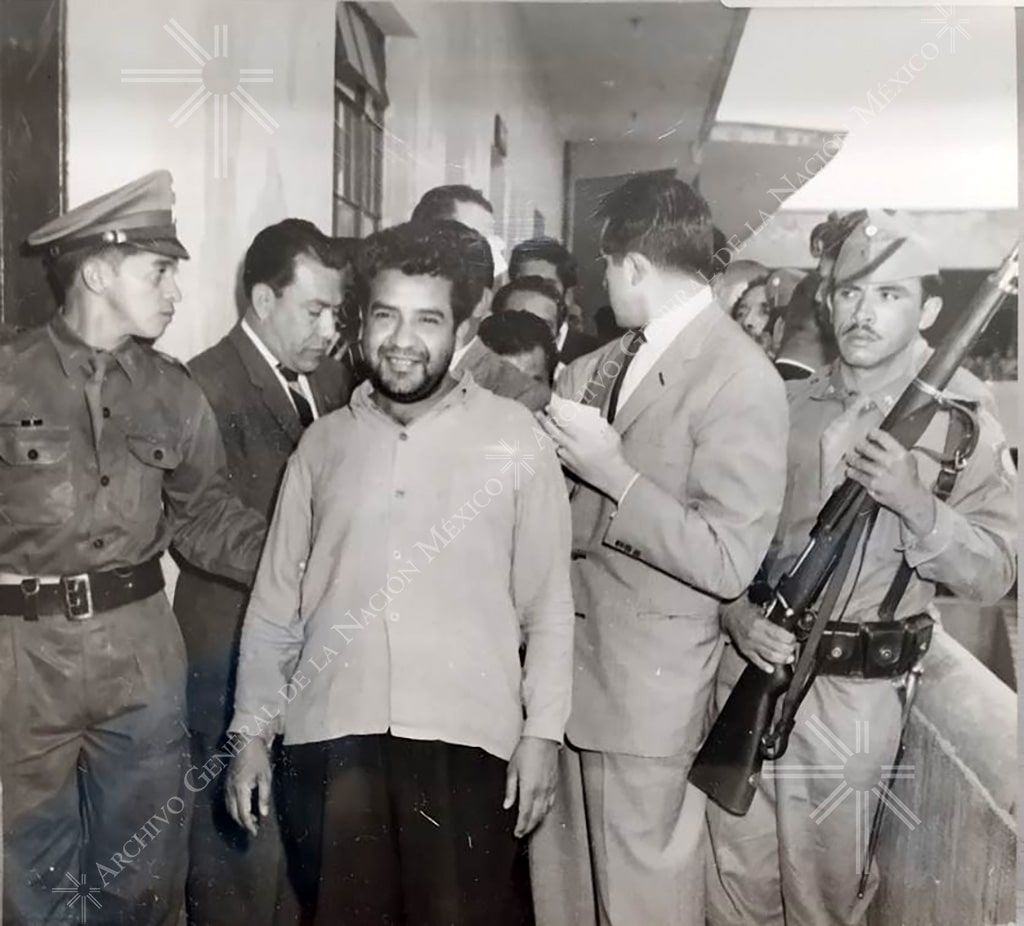Demetrio Vallejo, the railroad worker who fought against corporatism
The story of Demetrio Vallejo began in the town of El Espinal, Oaxaca, a few days before the outbreak of the Mexican Revolution. This famous social fighter ended up confronting the political, social, and economic structure that was established in Mexico with the shift to the right in the 1940s.

The story of Demetrio Vallejo began in the town of El Espinal, Oaxaca, a few days before the outbreak of the Mexican Revolution. Precisely on November 7, 1910, this famous social fighter was born and ended up confronting the political, social, and economic structure that was established in Mexico with the shift to the right in the 1940s.
At a very young age, he joined the railroads as a telegrapher. In 1948 he had his first participation in the railroad union movement that sought to achieve independence from the corporatism of the Institutional Revolutionary Party (PRI). However, this union movement was defeated, and the railroad workers' association was incorporated into the structure of the government and employers' apparatus of the State through the charrazo ("patronal"). That is, through the imposition of political leadership and its subordination to the control of the ruling party.
At the beginning of 1958, with the early departure of then-President Adolfo Ruiz Cortines and the conclusion of the railroad policy program for the six years 1953-1958, the plenary assembly of the Sindicato de Trabajadores Ferrocarrileros de la República Mexicana (STFRM) began a new struggle to negotiate with the company a better collective bargaining agreement to obtain higher wages and labor benefits. Demetrio Vallejo, together with his colleagues from the Oaxaca section, joined this new front.
The mobilization of the railroad workers began in May of that same year with the strong attendance of all the general secretaries of the 28 sections of the union. From the beginning, they created a "pro-wage increase commission", which adopted the Southeast Plan. Valentín Campa mentions that the objective of this plan was to establish a systematic organization among all the sections to obtain a salary increase of 350 pesos per month from the government. If the increase was denied, as a pressure maneuver, the strike would proceed progressively until a total work stoppage was reached at the company.
The outgoing administration stated that it could not grant the increase, arguing that the company was generating higher subsistence costs than productivity. The negative response set in motion the organization of the railroad workers, who took to the streets in June. The railroad struggle was arduous because the government was not willing to recognize the strike and instead implemented a series of legal and illegal methods to silence the "dissident" workers. They were branded from the beginning as traitors to the country under the label of "anti-Mexicans".
Thus, the State's informative organ, El Nacional, began to discredit the struggle of the railroad workers and union leaders such as Demetrio Vallejo and Valentín Campa. The rhetoric of the State's prevarication was present in every news item on the June railroad strike to justify the use of State power. The newspaper deployed among its front pages news full of intrigue, assuring the presence of "union irregularities committed by Vallejo, Campa and other agitators embedded in the union", as well as asserting that the people of the capital were clamoring to end the stoppages, forged, according to El Nacional, "not from the just and constitutional claim but the anti-Mexican attitude of the rash leaders".
That incipient strike for a better salary led to other demands within the railroad union, such as ending the famous "charrismo" within the STFRM that since the time of President Miguel Alemán had been established with the imposition of the leader Jesús Díaz de León, better known as "El Charro". The demand to hold elections to elect new union representatives was raised for July of that year. There was general support for the slate headed by Demetrio Vallejo, who won against José María Lara, another "charro" leader.
Achieving true democracy within the union and having the support of the Partido Comunista Mexicano (PCM), the Partido Obrero Campesino Mexicano (POCM) and the Partido Popular (PP) implied greater pressure on the company and the outgoing Ruiz Cortines administration, which were forced to give in to the workers' demands by providing a 250 peso wage increase.
Despite the apparent success of the 1958 strike, the new internal union organization continued working to win a better collective bargaining agreement. It was sought that this would include providing workers with comfortable and hygienic housing, a justified demand by constitutional article 123, section XI. To this petition was added solidarity with the unions of the minor railroad companies, whose collective bargaining agreements were treated separately. However, the regime of Adolfo López Mateos was inflexible in continuing to accept the demands of the railroad workers, and in exchange, they proposed the destabilization of their democratic union organization and the arrest of their leaders, especially Demetrio Vallejo and Valentín Campa.
In this regard, Campa pointed out that President Adolfo López Mateos, unlike his predecessor, embraced closer bilateral cooperation with the United States of America. From the beginning of his administration, the Mexican president met with his U.S. counterpart, Dwight D. Eisenhower, who led the "fever of fear of communism, of the expansion of Soviet influence in Latin America and of a nuclear attack". Keeping labor struggles at bay in Mexico was one of the central issues during the first meeting between the two leaders in February 1959.
As part of the cooperation between the two nations, a secret project was established with the Central Intelligence Agency (CIA) known as LIENVOY, renewed in 1967. This project directly involved Mexican authorities, including the president, with CIA station chiefs in Mexico, which proved to be a very productive exchange to identify individuals and political and social groups accused of "carrying out alleged or real communist activities".
The interference of the LIENVOY project in the railroad workers' struggle is not known for certain, however, Campa pointed out that the CIA directly advised the Mexican authorities with the purpose of crushing the strike-through its undercover agent whom he identified as Dean Stephanski. It is worth remembering that at the time the railroad strike was promoted, the media began to point out that it was a movement provoked by Soviet interference in Mexico, likewise, the STFRM was accused of being a space kidnapped by communists who did not represent the will of all railroad workers. That is to say, the anti-communist discourse began to have a greater application so that the Mexican government would justifiably act with full force, in this case against the railroad strike, which was finally ignored.
In the middle of Holy Week 1959, the authorities carried out a whole operation that consisted of pointing out the railroad strike as illegitimate; deploying the Army inside the facilities taken over by the workers; proceeding with massive dismissals, and arresting all the leaders of the STFRM under fabricated crimes.
Demetrio Vallejo was one of the first to be imprisoned in military camp number one, while Campa managed to escape, remained in the shadows and tried to communicate with former President Lázaro Cárdenas del Río so that he would mediate with President Adolfo López Mateos for guarantees for thousands of railroad workers fired or unjustly imprisoned. However, the new government was far from showing solidarity with the workers to resolve the great economic and social inequalities they suffered. Instead, the seeds of neoliberal restructuring and its policies began to grow stronger.
Demetrio was prosecuted for the crime of social dissolution, attacks on the general means of communication and against the country's economy. They were also imprisoned in the Federal District Penitentiary: Valentín Campa, Eladio Alemán Molina, Alfredo Rodríguez Andrade, Eugenio Jesús Araujo, Enrique Caballero Zárate, Roberto Gómez Godínez, Gil López Gómez, Enrique Sánchez Camarena, Manuel Jiménez Ramírez, José Guadalupe López Vargas, David López López, Ignacio Martínez Chávez, Raymundo Rangel Morales, Próspero Reyes Muñoz, Antonio Sánchez Rodríguez, David González Castillo, Máximo Correa Camargo, Francisco Carvallo Sandoval, among others unjustly charged. They spent eleven years in the Black Palace of Lecumberri, until after two six-year terms the pernicious articles 145 and 145 bis of the Federal Penal Code, which stipulated the crime of social dissolution, were repealed.
Finally, the workers' fighter Demetrio Vallejo, together with other leaders, was released from the Lecumberri Penitentiary on July 29, 1970. Upon his release, Campa would recognize the struggle led by the Mexican youth in 1968, who through organization and peaceful self-management managed to question the Mexican political system and authoritarian politics. Paradoxically, the repressive power that had acted on the students was one of the causes of the deterioration of the regime and the subsequent policy of democratic opening to recover consensus. There were still many struggles, prisoners, and decades to go before the authoritarian regime began to disintegrate.
More than 60 years after the events, we rescue the role of Demetrio Vallejo in the railroad strike as part of a collective struggle, whose steps we can follow from documents stored in the library and newspaper library Ignacio Cubas of the AGN. These testimonies of protagonists and antagonists shed light on the injustice suffered by those workers who were branded as anti-Mexican by the rhetoric of the government's prevarication in seeking better and fairer working conditions, as moments on the road to a freer, fairer, and more democratic society.




